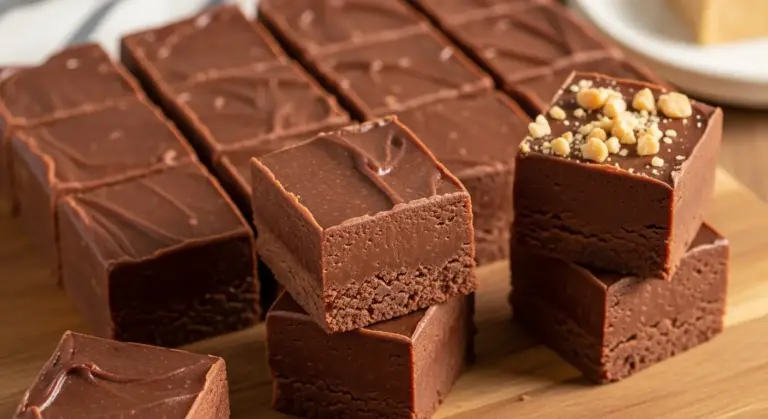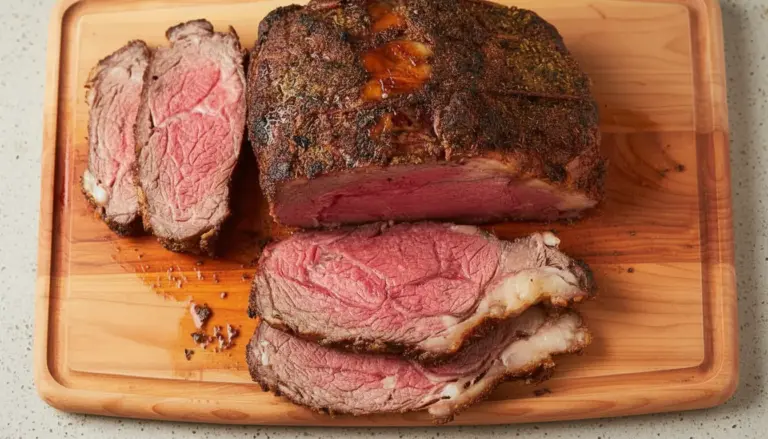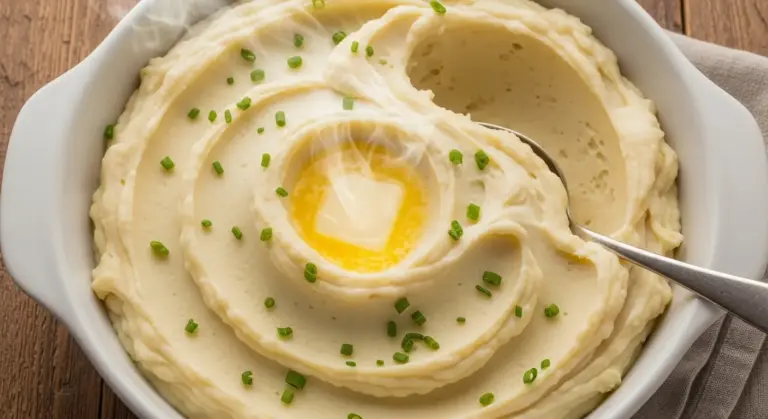I’ll never forget the first time I made tandoori chicken in my own kitchen. I was convinced you needed a traditional clay tandoor oven to get that signature charred exterior and juicy interior.
Turns out, I was wrong. After months of experimenting with different marinades and cooking methods, I finally cracked the code to making tandoori chicken recipe that rivals anything you’d get at an Indian restaurant. All you need is your regular oven (or grill) and the right spice blend.
The secret isn’t just about the spices—it’s about understanding the science behind the marinade. The yogurt tenderizes the meat while the kasuri methi (dried fenugreek leaves) adds that distinctive restaurant flavor most home cooks miss.
| Quick Recipe Summary | |
|---|---|
| Prep Time | 20 minutes (plus 4-8 hours marinating) |
| Cook Time | 35 minutes |
| Total Time | 55 minutes (plus marinating time) |
| Servings | 4-6 servings |
| Difficulty Level | Medium |
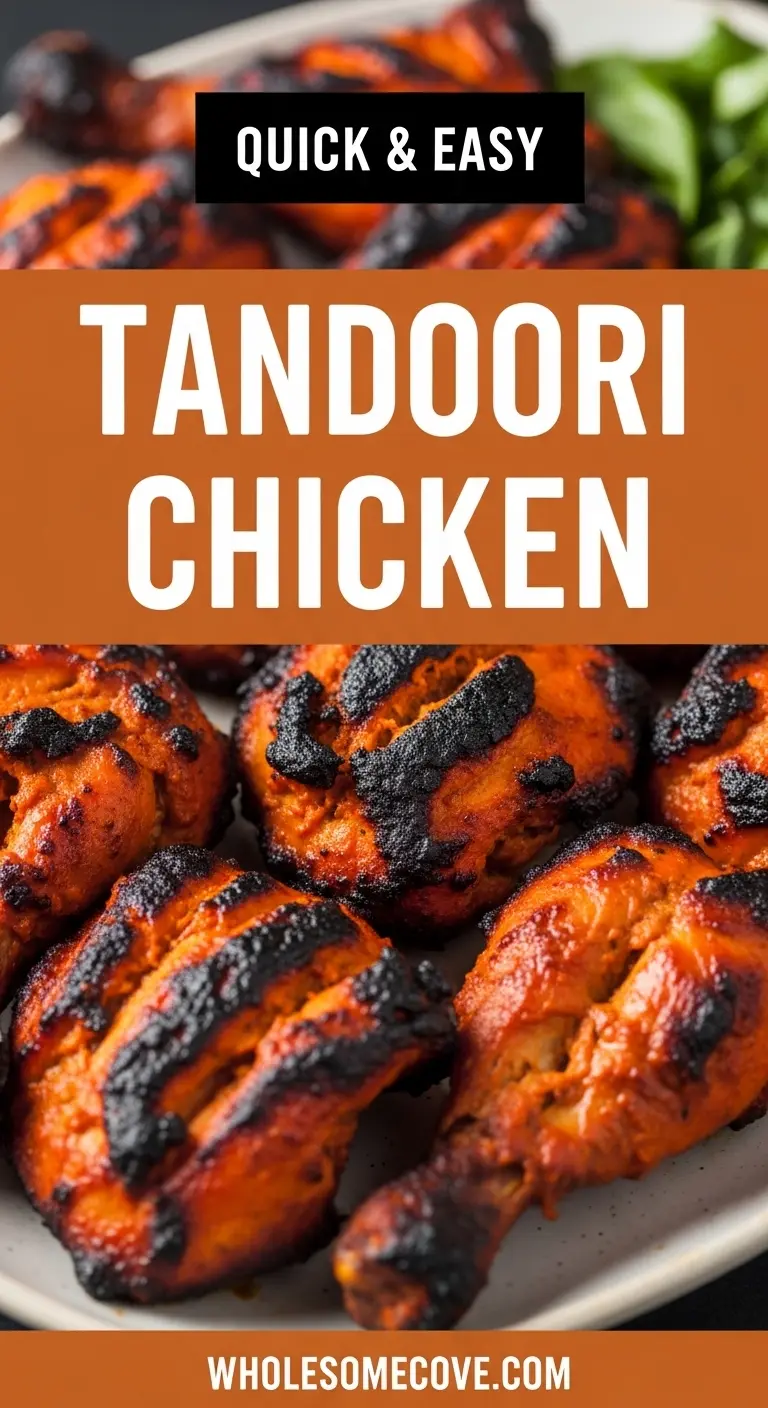
Why You’ll Love This Tandoori Chicken Recipe
This isn’t your average grilled chicken. The yogurt marinade creates an incredibly tender texture that practically falls off the bone, while the spice blend delivers layers of flavor without overwhelming heat.
I’ve simplified the traditional method without sacrificing authenticity. You get that gorgeous red-orange color, the slightly charred edges, and the smoky flavor—all from your home kitchen.
Here’s what makes this recipe special:
- Deep flavor penetration: The overnight marinade ensures every bite is packed with spices
- Restaurant-quality char: My oven technique mimics the intense heat of a tandoor
- Incredibly juicy meat: The yogurt and oil combination keeps the chicken moist even at high temperatures
- Customizable heat level: Adjust the chili powder to suit your spice tolerance
- Meal prep friendly: The marinated chicken keeps well in the freezer for up to 3 months
This pairs beautifully with my healthy hummus for a complete Indian-inspired feast.
Ingredients
The key to authentic tandoori chicken lies in using the right combination of spices and Greek yogurt for the marinade. I’ve learned that full-fat yogurt creates a richer, more tender result than low-fat versions.
For the Marinade:
- 2 lbs (900g) chicken pieces (drumsticks, thighs, or breasts), skin removed
- 1 cup (240ml) plain full-fat Greek yogurt
- 3 tablespoons lemon juice (about 2 lemons)
- 3 tablespoons ginger-garlic paste
- 2 tablespoons vegetable oil or mustard oil
- 2 teaspoons Kashmiri red chili powder (or regular chili powder)
- 2 teaspoons garam masala
- 1 teaspoon ground cumin
- 1 teaspoon ground coriander
- 1 teaspoon turmeric powder
- 1 teaspoon kasuri methi (dried fenugreek leaves), crushed
- 1½ teaspoons salt
- ½ teaspoon black pepper
- Red food coloring (optional, for traditional color)
For Basting:
- 2 tablespoons melted butter or ghee
- 1 tablespoon lemon juice
- ½ teaspoon chaat masala
For Serving:
- Lemon wedges
- Sliced onions
- Fresh cilantro
- Mint chutney (optional)
Kitchen Equipment Needed
Having the right tools makes all the difference when preparing tandoori chicken. Here’s what you’ll need to achieve that perfect restaurant-style char and juicy interior.
Essential Equipment:
- Large mixing bowl for marinating
- Baking sheet or grill pan
- Wire rack (for oven method)
- Silicone basting brush
- Meat thermometer
- Sharp knife for scoring chicken
- Measuring spoons and cups
- Aluminum foil
- Tongs
- Small bowl for basting mixture
Optional but Helpful:
- Outdoor grill or charcoal grill for authentic smoky flavor
- Metal skewers for grilling
- Food processor for making ginger-garlic paste from scratch
Recommended Products for This Recipe
After making tandoori chicken countless times, I’ve found that certain products really do make a noticeable difference in the final result. These are my go-to recommendations that I genuinely use in my own kitchen.
1. Kashmiri Red Chili Powder
This is the single most important spice for authentic tandoori chicken. Unlike regular chili powder, Kashmiri chili gives you that vibrant red color without overwhelming heat. I buy mine in bulk because I use it constantly for Indian cooking, and the flavor is so much better than regular chili powder.
2. Cast Iron Grill Pan
If you don’t have access to an outdoor grill, a heavy-duty cast iron grill pan is your best friend. It gets scorching hot and creates those beautiful char marks that make tandoori chicken look (and taste) restaurant-quality. Mine is 10 years old and still performs like new.
3. Instant-Read Meat Thermometer
This tool has saved me from serving dry chicken more times than I can count. Tandoori chicken needs to reach 165°F (74°C) internal temperature, but even a few degrees over can make it dry. A good thermometer takes the guesswork out completely.
4. Kasuri Methi (Dried Fenugreek Leaves)
This is the “secret ingredient” that gives tandoori chicken its distinctive restaurant flavor. Most home cooks skip it, but you’ll immediately taste the difference when you include it. A little goes a long way—I crush it between my palms before adding it to release the oils.
Read Also: Chicken Adobo Recipe
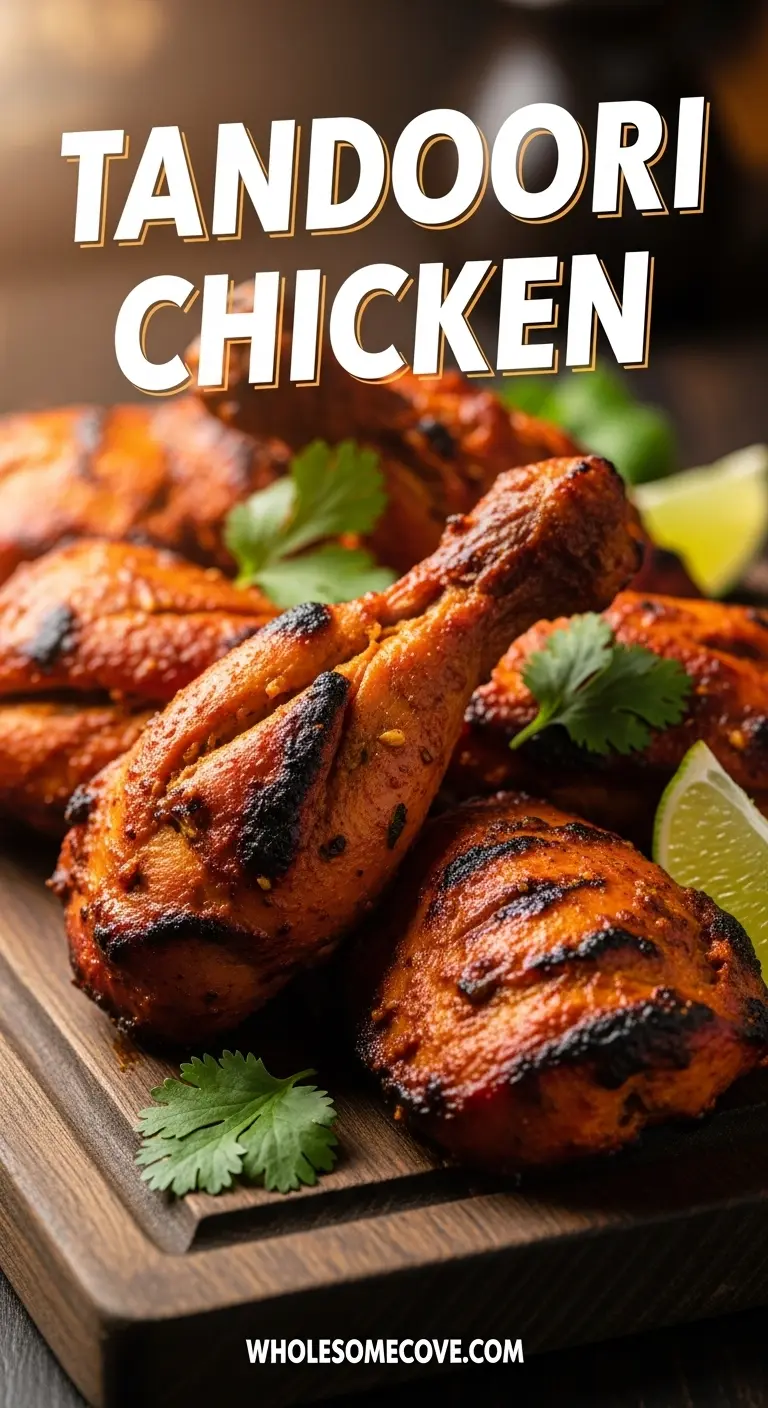
Step-by-Step Instructions: How to Make Tandoori Chicken
Follow these detailed steps for perfectly charred, juicy tandoori chicken. The key is patience—don’t rush the marinating time.
1. Prepare the Chicken
- Remove the skin from the chicken pieces using paper towels for better grip
- Make 2-3 deep diagonal slashes (about ½ inch deep) on each piece to help the marinade penetrate
- Pat the chicken completely dry with paper towels—excess moisture prevents the marinade from adhering properly
- Place the scored chicken pieces in a large mixing bowl
- Squeeze fresh lemon juice over the chicken and add 1 teaspoon of salt
- Mix well with your hands, making sure the lemon juice gets into the cuts
- Let it sit for 10 minutes while you prepare the marinade (this pre-seasoning step is crucial for flavor)
2. Make the Marinade
- In a separate bowl, combine the Greek yogurt, ginger-garlic paste, and remaining lemon juice
- Whisk until smooth and well combined
- Add all the ground spices: Kashmiri chili powder, garam masala, cumin, coriander, and turmeric
- Crush the kasuri methi between your palms to release its oils, then add it to the mixture
- Add the remaining salt, black pepper, and vegetable oil
- If using food coloring for that traditional bright red-orange hue, add 2-3 drops now
- Whisk everything together until you have a smooth, thick marinade with no lumps
- The marinade should be the consistency of thick pancake batter
3. Marinate the Chicken
- Pour the marinade over the lemon-rubbed chicken pieces
- Using your hands (I recommend wearing disposable gloves), massage the marinade into every piece
- Make sure to work the marinade into all the cuts and coat every surface thoroughly
- Cover the bowl tightly with plastic wrap or transfer everything to a large ziplock bag
- Refrigerate for a minimum of 4 hours, but overnight (8-12 hours) is ideal for maximum flavor
- Turn the chicken pieces once or twice during marinating if you remember
- Remove from the refrigerator 30 minutes before cooking to bring to room temperature
Another favorite: Teriyaki Grilled Chicken Recipe
4. Preheat and Prepare for Cooking
For Oven Method:
- Position your oven rack in the top third of the oven
- Preheat to 450°F (230°C) for at least 20 minutes—the oven needs to be screaming hot
- Line a large baking sheet with aluminum foil for easy cleanup
- Place a wire rack on top of the lined baking sheet
- Lightly brush the wire rack with oil to prevent sticking
For Grill Method:
- Preheat your grill to high heat (around 450-500°F/230-260°C)
- If using charcoal, wait until the coals are white-hot
- Oil the grill grates well to prevent sticking
- If using skewers, thread the chicken pieces onto metal skewers
5. Cook the Chicken (Oven Method)
- Remove chicken from marinade, letting excess drip off (don’t wipe it clean—you want some marinade on there)
- Arrange chicken pieces on the wire rack with space between each piece for air circulation
- Place the baking sheet on the top rack of the preheated oven
- Roast for 20 minutes without opening the oven door
- After 20 minutes, flip each piece using tongs
- Continue roasting for another 12-15 minutes until the chicken is cooked through
- Check internal temperature with a meat thermometer—it should read 165°F (74°C) in the thickest part
- If you want more char, turn on the broiler for the last 2-3 minutes, watching carefully to prevent burning
6. Cook the Chicken (Grill Method)
- Place marinated chicken pieces directly on the hot, oiled grill grates
- Close the lid and cook for 7-8 minutes without moving the chicken
- Flip the pieces carefully and cook for another 7-8 minutes on the other side
- Move chicken to indirect heat if it’s browning too quickly
- Continue cooking until internal temperature reaches 165°F (74°C)
- The total cooking time will be 20-25 minutes depending on the size of your pieces
- For extra char, move back to direct high heat for the last 2 minutes on each side
7. Baste and Finish
- While the chicken is cooking, prepare the basting mixture by combining melted butter or ghee with lemon juice and chaat masala
- During the last 5 minutes of cooking, brush this mixture generously over the chicken pieces
- This adds an extra layer of flavor and gives that glossy, restaurant-style finish
- If grilling, this is also when you can create a “dhungar” (smoking) effect by placing a small piece of burning charcoal in a heat-proof bowl on the grill near the chicken
- Once cooked, remove chicken from heat and let it rest for 5 minutes before serving
- This resting period allows the juices to redistribute throughout the meat
8. Serve
- Transfer the tandoori chicken to a serving platter
- Squeeze fresh lemon juice over the top
- Garnish with thinly sliced onions, fresh cilantro, and additional chaat masala if desired
- Serve immediately while hot with lemon wedges on the side
- Traditionally served with mint chutney, naan bread, or rice
You might also enjoy: Grilled Lemon Herb Chicken Recipe
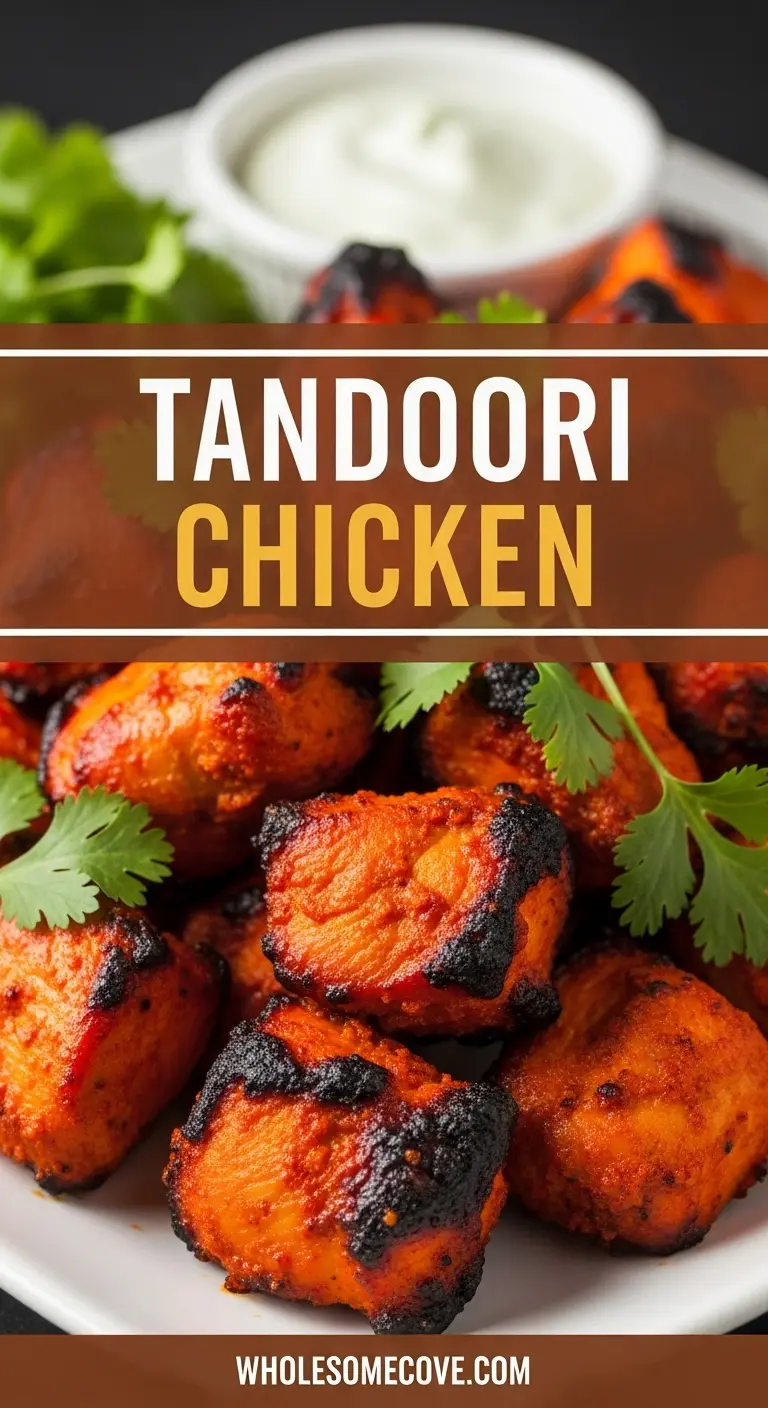
Tips for The Best Tandoori Chicken
After making this recipe dozens of times and learning from my mistakes, here are my top tips for tandoori chicken perfection. These small details make a huge difference in the final result.
Pro Tips:
- Always use bone-in chicken: Boneless pieces dry out too quickly at high heat. Bone-in thighs and drumsticks stay juicier and have better flavor.
- Don’t skip the scoring: Those deep cuts aren’t just decorative—they allow the marinade to penetrate deep into the meat. Make them at least ½ inch deep.
- Use full-fat yogurt: Low-fat or fat-free yogurt makes a watery marinade that doesn’t cling to the chicken properly. Greek yogurt works best because of its thick consistency.
- Marinate overnight: While 4 hours is the minimum, overnight marinating (8-12 hours) produces significantly more flavorful chicken. The yogurt’s enzymes need time to tenderize the meat.
- Bring chicken to room temperature: Cold chicken straight from the fridge won’t cook evenly. Let it sit out for 30 minutes before cooking.
- Preheat properly: Your oven or grill needs to be extremely hot before the chicken goes in. This creates that signature char without overcooking the inside.
- Use a meat thermometer: This is non-negotiable. Overcooked tandoori chicken is dry and disappointing. Pull it off the heat the moment it reaches 165°F (74°C).
- Don’t overcrowd: Leave space between chicken pieces for air circulation. Crowded chicken steams instead of roasting and won’t develop that charred exterior.
- Save extra marinade: Before adding raw chicken, set aside 2-3 tablespoons of marinade in a separate bowl. Use this fresh marinade for basting or as a sauce (never use marinade that touched raw chicken).
- Create smoke at home: For authentic tandoor flavor, place a small piece of burning charcoal in a heat-proof bowl, set it on your grill or in your oven (in a safe spot), and drizzle a bit of ghee over it to create smoke during the last few minutes of cooking.
- Rest before serving: Let the chicken rest for 5 minutes after cooking. Cutting into it immediately causes all those delicious juices to run out.
- Adjust spice levels: Kashmiri chili powder is mild. If you want more heat, add cayenne pepper or extra regular chili powder to taste.
For a lighter option, try: Healthy Orange Chicken Recipe
Serving Suggestions
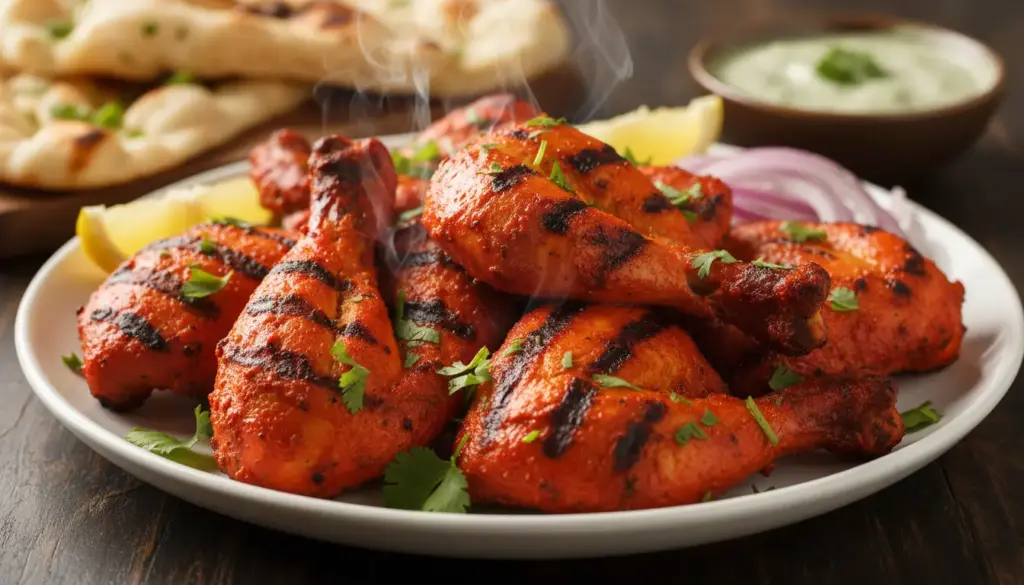
Tandoori chicken is incredibly versatile and pairs well with numerous side dishes and accompaniments. Here’s how I typically serve it at home.
Traditional Indian sides make this meal complete:
- Naan or roti: Warm, pillowy bread is essential for scooping up the chicken and any leftover marinade
- Basmati rice: Plain steamed rice or healthy fried rice balances the spices perfectly
- Mint chutney: The cooling effect of fresh mint contrasts beautifully with the smoky, spiced chicken
- Raita: Cucumber yogurt sauce adds a refreshing element to the meal
- Pickled onions: Thinly sliced onions marinated in lemon juice and salt cut through the richness
- Dal (lentil curry): Creamy lentils complement the charred chicken wonderfully
- Roasted vegetables: Try it with grilled vegetable skewers for a complete spread
- Fresh salad: A simple cucumber-tomato salad with lemon dressing lightens the meal
- Mango chutney: Sweet and tangy chutney adds another layer of flavor complexity
I also love using leftover tandoori chicken in wraps, over salads, or chopped up in healthy fried rice the next day.
Variations of Tandoori Chicken
Once you master the basic recipe, these variations keep things interesting. I rotate through these depending on what I’m craving or what’s in my pantry.
Delicious ways to customize this recipe:
- Tandoori Chicken Tikka: Cut boneless chicken into 1-inch cubes, marinate the same way, and thread onto skewers. Reduce cooking time to 12-15 minutes total. Perfect for appetizers.
- Green Tandoori (Hariyali): Replace the red chili powder with green chutney made from cilantro, mint, green chilies, and lime juice. The chicken turns a beautiful green color and has a fresher, herbaceous flavor.
- Achari Tandoori: Add 1 tablespoon of pickling spices (fennel seeds, nigella seeds, fenugreek seeds, mustard seeds) to the marinade for a tangy, pickle-flavored version.
- Malai Tandoori: Add ¼ cup heavy cream and 2 tablespoons of cashew paste to the marinade. Reduce chili powder by half. This creates a milder, creamier version that’s less spicy.
- Afghani Tandoori: Use white pepper instead of black, and replace the yogurt with a mixture of hung curd and cheese. The result is paler in color but incredibly rich.
- Peri-Peri Tandoori: Add 2 tablespoons of peri-peri sauce to the marinade for a spicy, tangy African-Indian fusion.
- Lemon-Pepper Tandoori: Add the zest of 2 lemons and increase black pepper to 1 tablespoon for a citrusy, peppery variation.
- Whole Chicken Tandoori: Use a whole spatchcocked chicken (butterflied) instead of pieces. Increase cooking time to 45-55 minutes. Perfect for impressive dinner parties.
- Tandoori Paneer or Tofu: For vegetarians, cube paneer cheese or extra-firm tofu, marinate the same way, and grill. Reduce cooking time to 10-12 minutes.
Read Also: Chicken Parmesan Recipe
Storage and Reheating
Proper storage ensures your tandoori chicken stays delicious for days. I often make a double batch specifically for meal prep throughout the week.
Storage guidelines:
- Refrigerator: Store cooked tandoori chicken in an airtight container for up to 4 days. Keep it separate from any sauce or accompaniments.
- Freezer: Cooked chicken freezes beautifully for up to 3 months. Wrap individual pieces tightly in plastic wrap, then place in a freezer-safe bag. Label with the date.
- Marinated raw chicken: Uncooked marinated chicken keeps in the fridge for up to 2 days or in the freezer for up to 3 months. Thaw frozen marinated chicken in the refrigerator overnight before cooking.
- Marinade only: Unused marinade (that never touched raw chicken) can be refrigerated for up to 1 week in an airtight container.
Reheating methods:
- Oven (best method): Preheat oven to 350°F (175°C). Place chicken on a baking sheet, cover loosely with foil, and heat for 15-20 minutes until warmed through. Remove foil for the last 5 minutes to crisp the exterior.
- Microwave (quickest): Place chicken on a microwave-safe plate, cover with a damp paper towel, and heat in 30-second intervals until hot. This method works but may make the exterior less crispy.
- Stovetop: Heat a skillet over medium heat with a bit of oil or butter. Add chicken pieces and cook, turning occasionally, until heated through (about 8-10 minutes).
- Air fryer: This is my favorite reheating method. Set to 350°F (175°C) and heat for 5-7 minutes. The chicken comes out almost as good as freshly made with a nicely crisped exterior.
- Grill: If your grill is already hot, place cold chicken on indirect heat for 8-10 minutes, turning once.
Never refreeze previously frozen cooked chicken, and always reheat to an internal temperature of 165°F (74°C) for food safety.
For a lighter option, try: Grilled Chicken and Veggie Skewers Recipe
Nutritional Facts
Per serving (1 piece of chicken, approximately 150g):
- Calories: 285
- Total Fat: 14g
- Saturated Fat: 4g
- Trans Fat: 0g
- Cholesterol: 125mg
- Sodium: 520mg
- Total Carbohydrates: 6g
- Dietary Fiber: 1g
- Sugars: 3g
- Protein: 34g
- Vitamin A: 8% DV
- Vitamin C: 6% DV
- Calcium: 10% DV
- Iron: 12% DV
Note: Nutritional values are approximate and vary based on the specific cuts of chicken used and the exact measurements of ingredients. Values are based on chicken thighs with the skin removed.
Health Benefits of Key Ingredients
Tandoori chicken isn’t just delicious—it’s actually quite nutritious when prepared with quality ingredients. The cooking method requires minimal oil, and the spices offer numerous health benefits.
Nutritional highlights of this recipe:
- Greek Yogurt: Provides probiotics for gut health, high-quality protein, calcium for bone health, and contains less lactose than regular yogurt. The lactic acid in yogurt also helps tenderize the chicken naturally, making it easier to digest.
- Turmeric: Contains curcumin, a powerful anti-inflammatory compound linked to improved brain function and reduced risk of chronic diseases. It also supports joint health and may boost the immune system.
- Ginger and Garlic: Both are antimicrobial and anti-inflammatory. Ginger aids digestion and may reduce nausea, while garlic supports heart health and may help lower blood pressure and cholesterol levels.
- Lean Protein: Skinless chicken is an excellent source of lean protein, essential for muscle maintenance, weight management, and keeping you feeling full longer. Dark meat (thighs and drumsticks) provides more iron and zinc than breast meat.
- Cumin: Rich in iron and may improve digestion. Studies suggest it can help control blood sugar levels and boost the immune system.
- Coriander: Contains antioxidants that may lower blood sugar and support heart and brain health. It’s also traditionally used to aid digestion.
- Kasuri Methi (Fenugreek): May help regulate blood sugar levels, reduce inflammation, and improve cholesterol levels. It’s particularly beneficial for diabetics and those watching their blood sugar.
- Lemon Juice: High in vitamin C, supports immune function, aids in iron absorption from the chicken, and acts as a natural meat tenderizer without adding calories.
- Minimal Added Fats: Unlike fried chicken, tandoori chicken uses very little oil, making it a heart-healthier option while still delivering maximum flavor through spices rather than fat.
Read Also: Baked Chicken With Alfredo Sauce Recipe
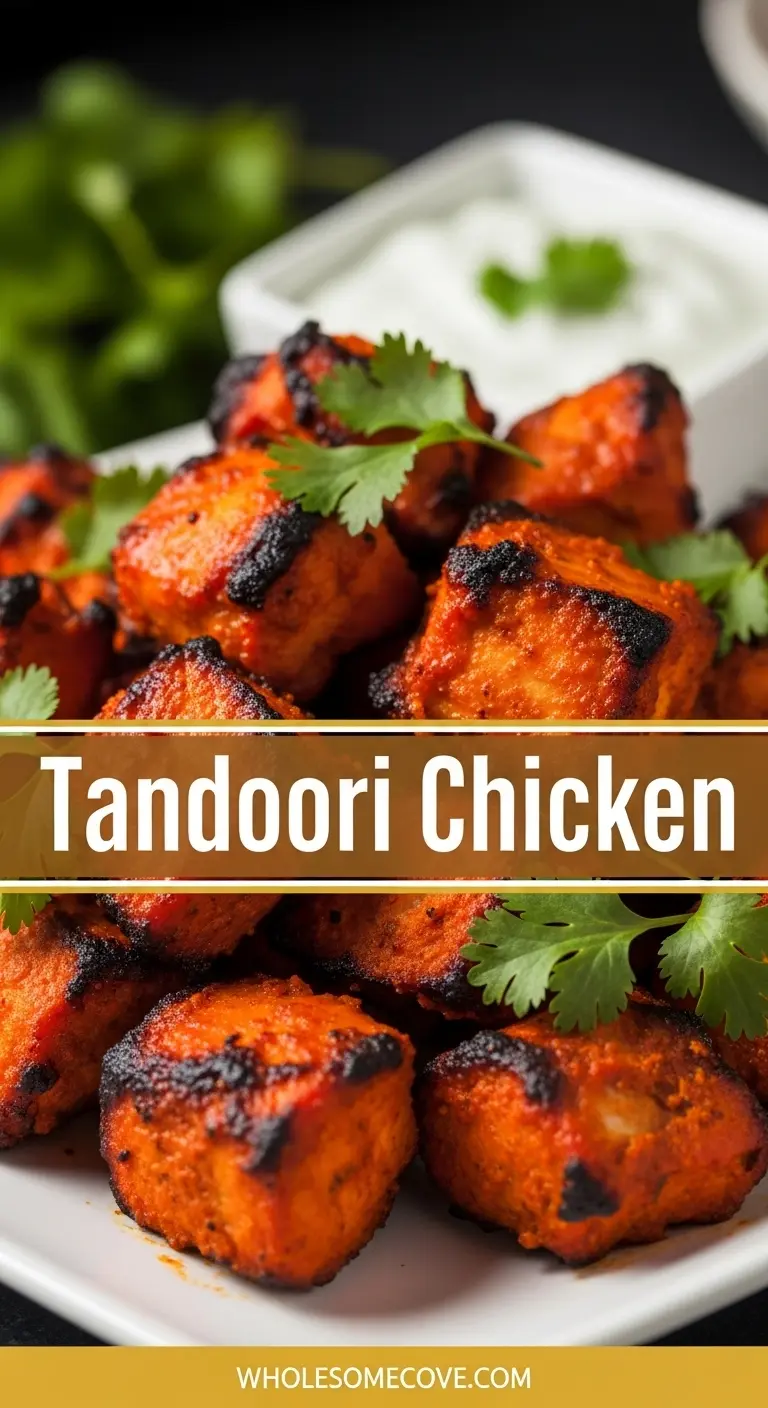
FAQs About Tandoori Chicken
1. Can I make tandoori chicken without a tandoor oven?
Absolutely! That’s exactly what this recipe is designed for. A regular oven set to high heat (450°F/230°C) or an outdoor grill works beautifully. The key is getting your cooking surface very hot before adding the chicken to mimic the intense heat of a traditional tandoor. I’ve been making it this way for years, and guests can’t tell the difference.
2. Why is my tandoori chicken dry?
Dry tandoori chicken usually happens for one of three reasons: using boneless, skinless breast meat (which has less fat), overcooking past 165°F internal temperature, or not marinating long enough.
Always use a meat thermometer and pull the chicken off the heat the moment it reaches 165°F. Also, bone-in dark meat (thighs and drumsticks) stays much juicier than breast meat at high temperatures.
3. Can I use boneless chicken for this recipe?
You can, but you’ll need to adjust the cooking time significantly. Boneless chicken cooks much faster—usually 15-20 minutes total instead of 30-35 minutes. The challenge is that boneless pieces are more prone to drying out at high heat, so watch them carefully and check the temperature frequently. I recommend sticking with bone-in for the juiciest results.
4. What can I substitute for kasuri methi (dried fenugreek leaves)?
Kasuri methi has a unique flavor that’s hard to replicate, but if you absolutely can’t find it, you can use a combination of dried oregano and a pinch of maple syrup (about ½ teaspoon) to mimic the slightly sweet, earthy flavor.
Fresh fenugreek leaves work too if you have access to them—use about 2 tablespoons chopped fresh leaves. That said, kasuri methi is readily available online and in Indian grocery stores, and it’s worth seeking out for authentic flavor.
5. How do I get that bright red-orange color in restaurant tandoori chicken?
Restaurants typically use red food coloring to achieve that vivid color. While Kashmiri chili powder does provide some color, it won’t give you that intense red-orange hue on its own. If you want the traditional look, add 2-3 drops of red gel food coloring to your marinade.
You can also use a tiny pinch of saffron soaked in warm milk for a natural yellow-orange tint, though this won’t give you the bright red color. Personally, I often skip the food coloring—the flavor is what matters most.
You might also enjoy: Chick Fil A Grilled Chicken Nuggets Recipe
Final Thoughts
Making restaurant-quality tandoori chicken at home is absolutely achievable with the right technique and a bit of patience. Once you master this recipe, you’ll find yourself making it regularly for weeknight dinners, meal prep, and special occasions alike.
The beauty of tandoori chicken is its versatility—serve it traditionally with naan and raita, throw it on top of a salad for lunch, or shred it into wraps for an easy dinner. The leftovers might actually taste even better the next day as the flavors continue to develop.
Don’t be intimidated by the long ingredient list or the marinating time. The actual hands-on work is minimal, and the results are absolutely worth it. Give this recipe a try, and I guarantee you’ll be adding it to your regular rotation.
Have you tried making tandoori chicken at home? I’d love to hear about your experience and any variations you’ve created. Drop a comment below and let me know how it turned out!
Recommended:
- Chicken Chesapeake Recipe
- Easy Marry Me Chicken Recipe
- Marry Me Chicken Pasta Recipe
- Healthy Chicken Parmesan Recipe
- Chicken Caprese Skillet Recipe
- Greek Chicken Gyros Recipe
- Asian Chicken Lettuce Cups Recipe
- Air Fryer Chicken Drumsticks Recipe
- Air Fryer Chicken Breast Recipe
- Mexican Chicken Salad Recipe


